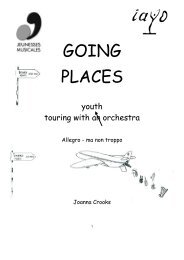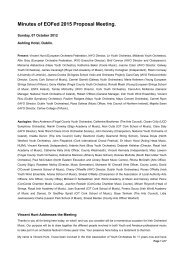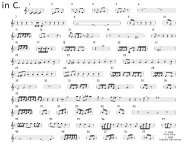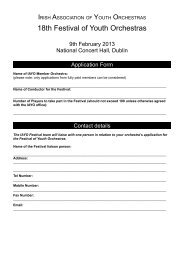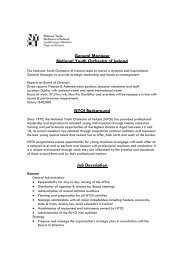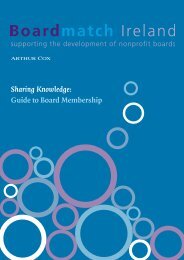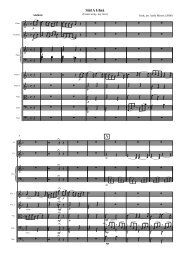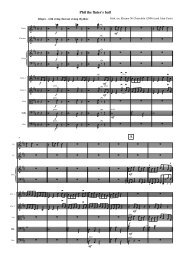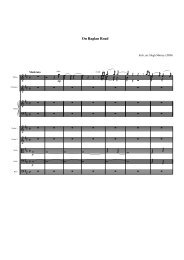A SOUND EAR II - Association of British Orchestras
A SOUND EAR II - Association of British Orchestras
A SOUND EAR II - Association of British Orchestras
Create successful ePaper yourself
Turn your PDF publications into a flip-book with our unique Google optimized e-Paper software.
A <strong>SOUND</strong> <strong>EAR</strong> <strong>II</strong><br />
Summary <strong>of</strong> findings<br />
The good news is that three years on from the first <strong>of</strong>ficial training sessions in Leeds (Orchestra <strong>of</strong> Opera North)<br />
there appears to be general consensus about the need to take action. Many initiatives have taken hold, and there is a<br />
rising level <strong>of</strong> good practice. Musicians have realised that the law is there to protect them, not to destroy orchestras,<br />
and have shared with management their views on the best way to take control <strong>of</strong> the problems. Misunderstandings<br />
have been resolved and most cynics won over to a method <strong>of</strong> trial and experiment. There is a slight risk that just a<br />
very small number <strong>of</strong> people in authority may think themselves above the law and intend to take no action to protect<br />
their players. This would be an arrogant and short-sighted view and could be against the interests <strong>of</strong> the whole<br />
pr<strong>of</strong>ession. However, there does appear to be a strong and extremely positive movement across the sector towards<br />
training, understanding and action.<br />
Training<br />
The announcement <strong>of</strong> the important training initiative launched by the ABO in 2004, with generous financial support<br />
from the MBF, received an enthusiastic response, especially from contract orchestra managements who were able<br />
to schedule the time for the sessions into existing plans, avoiding extra costs. Managements <strong>of</strong> freelance orchestras,<br />
although keen to <strong>of</strong>fer the training to their core members, found it more difficult to organise because <strong>of</strong> the need to<br />
pay fees for the time involved, but nevertheless some, especially the self-governing London orchestras, found a way.<br />
In the first wave <strong>of</strong> training, which started in December 2004, a cross-section <strong>of</strong> ABO members took advantage <strong>of</strong> the<br />
subsidised sessions with Alison Wright Reid. The choice <strong>of</strong> orchestras in this evaluation reflects the diversity.<br />
The four orchestras: The Orchestra <strong>of</strong> the Royal Opera House, the Bournemouth Symphony Orchestra,<br />
Northern Sinfonia and the London Philharmonic Orchestra.<br />
The purpose is this evaluation was to assess the value and the outcomes <strong>of</strong> the training to each <strong>of</strong> the orchestras, in<br />
order to give the ABO and the MBF clear guidelines about future initiatives, in relation to value for money and health<br />
and safety, and to inform the pr<strong>of</strong>ession about action plans and best practice established post-training.<br />
What was uncovered was a very interesting, encouraging, yet diverse range <strong>of</strong> responses and a surprising spectrum<br />
<strong>of</strong> opinions about the training and reactions to it. But the one common fact which emerged from discussions with<br />
orchestral musicians was that, whatever they thought about the quality, or even the delivery, <strong>of</strong> the sessions, they had all<br />
got the message. They may not all have liked it, but that is another matter. Here are some <strong>of</strong> the comments by players:<br />
“The technical aspects <strong>of</strong> the ABO sessions were frighteningly clear but the solutions were not so obvious…”<br />
“...the handouts were very useful in making us see the dangers to our hearing and general well-being, should we continue with<br />
the same working conditions.”<br />
“As a result <strong>of</strong> the training, people do feel more confident in actually standing up in rehearsal and saying that the noise is<br />
unacceptable ... the point was made (to the conductor) ... when rehearsing the opening <strong>of</strong> Janacek that it did not have to be<br />
played fortissimo in rehearsal. He was not too thrilled but took the point!”<br />
“...the ‘training day’ has not proved particularly memorable for me. All the theory in the world does not alter the aural discomfort<br />
<strong>of</strong> a ‘bad’ seating position.”<br />
“No one could deny that the training taught us some uncomfortable facts and confirmed what many suspected, but we all got a<br />
bit hung up on the ear plug question, rather than what might be done before it comes to that.”<br />
“As for educating conductors ... I guess it is up to management to address long before the conductor gets anywhere near the<br />
orchestra. Because <strong>of</strong> our training, people are much more willing to confront a conductor in rehearsal than in the past. It should<br />
not ever be necessary though! Hopefully, gone are the days when Solti said to us in a ‘FRAU’ rehearsal - “play anything you like<br />
as long as it is loud!”<br />
“There was some resistance but it helped that a small group had a preliminary session with Alison Wright-Reid.”<br />
“Our trumpets went into the training having been willing to use screens and came out refusing on the grounds that they were<br />
dangerous! I am not sure that was the intended message <strong>of</strong> the training...!!”<br />
All the musicians interviewed were determined to co-operate in finding ways <strong>of</strong> changing working practices to improve<br />
safety and to comply with the Noise at Work Regulations. Very little complacency was detected on the part <strong>of</strong> the<br />
31



